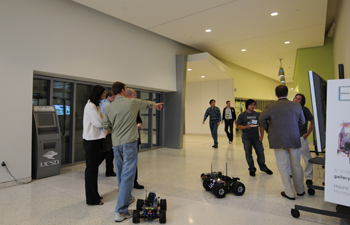FiRe CTO Challenge: Using Technology to Fight Wildfires
By Tiffany Fox, tfox@ucsd.edu
San Diego, CA, May 31, 2008 -- Organizers of the 2008 Future in Review (FiRe) workshop focused attention this year on 'Rapid Response' to societal-scale problems, with a particular focus on global climate change. [For a companion article on the FiRe special event held at the UCSD division of Calit2, click here .]
"The bottom line out of this conference is that there is a greatly increased sense of urgency about global climate change," said Calit2 Director Larry Smarr. "When you are facing a situation like global warming, the more you can do early, the greater impact it has. It's a race against time."
|
As part of what he calls a "methodological breakthrough," Smarr arranged for top leadership from local government and fire-response teams to attend the FiRe conference and present their experience about the real-world hardships of fighting Santa Ana wind-driven wildfires. Speakers included San Diego County Supervisor Ron Roberts, County Fire Chief William Metcalf, and Ron Lane, Director of the County's Office of Emergency Services. These officials, along with a team that included CTOs from Intuit, Symantec, EMC, Avanade and Microsoft, collaborated on the challenge and presented their findings on the final day of the conference.
Their suggested solution: an integrated information architecture focused on providing early warning, enabling rapid response, and providing the public and first responders with access to up-to-date situational awareness of where the fires are and how to evacuate safely. Ron Roberts said that the additional presence of UCSD, SDSU and the U.S. Navy makes San Diego a national prototype for using technology to increase our ability to respond to these devastating wildfires.
Observed FiRe founder Mark Anderson: "Looking at the impact of technology on fighting wildfires, together with Calit2's ability to bring in the front-line commanders of the San Diego firestorms, transformed our CTO Challenge from an interesting tech conversation to a globally important technical contribution. We hope that cities around the world will benefit from San Diego's steps forward."
"The question it comes down to is, 'Why is it important that Calit2 live in the future?'" said Smarr. "For me, it's because time is our enemy. The complexity of the problems that the state and the planet face -- whether fire, water, transportation, gridlock -- all of these things are happening on a much more extreme time scale. We need to understand possible solutions sooner than ever before."
Future in Review is a trademark held by Strategic News Service.
Related Links
Future in Review Workshop
FiRe Visit to Calit2
Related Articles
Top Technology Industry Officials Visit Calit2 at UC San Diego During 'Future in Review' Conference


